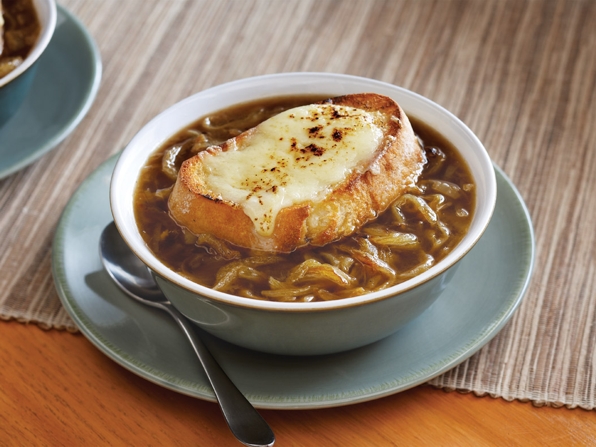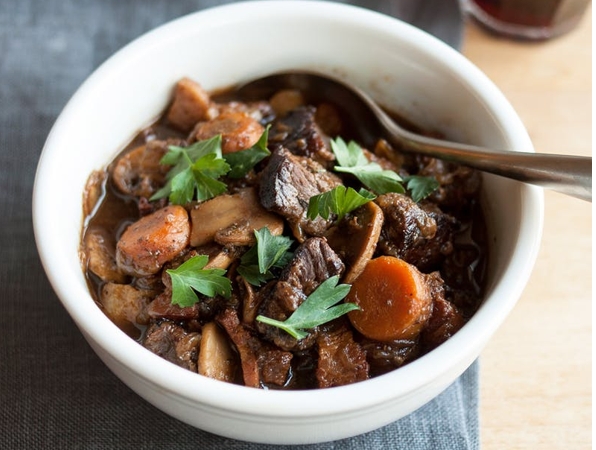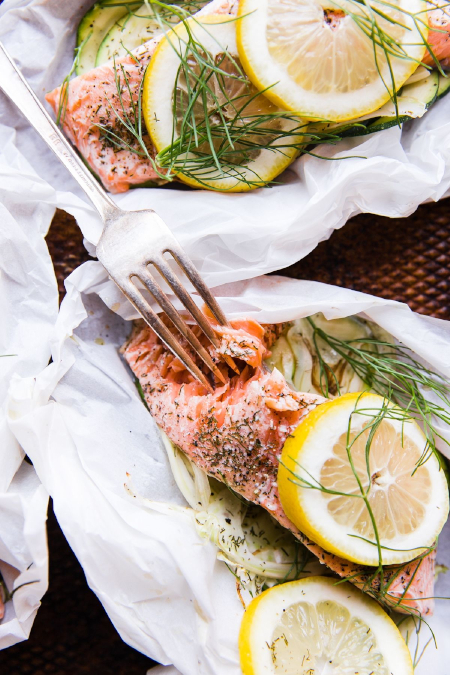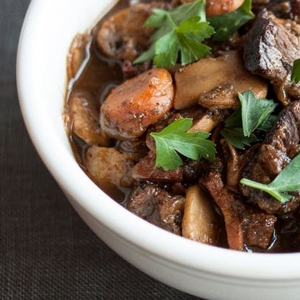Sounds odd, I know… But many of the great dishes and dining conventions attributed to the French might never have come about had it not been for a royal marriage in 1547 which saw a determined Queen Consort bring all the comforts she missed from home to her new abode in Paris…
 Classic French Onion Soup: Golden slivered onions, a rich broth
Classic French Onion Soup: Golden slivered onions, a rich broth
and a huge French Bread crouton topped with cheese…
Catherine de’ Medici married king Henry II of France as part of one of those intra-European peace-keeping efforts of the Elizabethan era that ended up creating one of the greatest cuisines in the world. It also introduced many of the dining conventions we now take for granted to the highest echelons of European society.
When Catherine landed in France, she found even the most noble of her new subjects still ate with their hands and a dagger off a wooden slab. The odd one employed a spoon for certain dining chores, but cutlery as we know it today had not yet come into vogue. Neither had some key ingredients Catherine was used to eating back home in Italy. Nor were French chefs anywhere near up to her standard. So she imported a small army of Italian cooks, ‘essential’ ingredients such as pasta and tomatoes, and dining experience refinements including table cloths, plates and forks.
Then, after she had settled in, Catherine made it her duty to tour every corner of France in an extended royal progress intended to discover, codify and record every regional ingredient and recipe worth immortalizing. And that’s how the French cuisine we know today came to be – with strong regional identities and a vast array of ingredients that exemplify a total, unified French food culture.
On our menu today
Just a few examples of well-known dishes that benefited from Catherine de’ Medici’s influence on French dining culture…
Soupe à l’Oignon: Who hasn’t tried French Onion Soup? Very few of us, I dare say! (See photo, above.) The classic soup’s unique flavour comes from the very slow simmering and caramelization of lots of onions (0ne recipe I’ve seen calls for 700 g / 1.5 lb. for a soup to serve 4!), the addition of a rich beef stock, and a final lick of Sherry or Brandy. Proper French Onion Soup is always garnished with a thin toasted slice of French Bread topped with a classic melting cheese such as Gruyere or Emmenthal. Serve piping hot in deep, heavy stoneware bowls.
Coq au Vin: It is what it says: Chicken in red wine. Who says red wine doesn’t go with poultry? Simply braise chicken parts in Burgundy wine, bacon morsels, mushrooms, onions, and garlic. Serve with a potato side and a medley of boiled or braised root veggies. Like the Onion Soup, this dish requires long slow coking to produce the rich reduction sauce it’s famous for. As with many French dishes, a dash of Brandy is often applied at the end of cooking. For the ultimate Coq au Vin recipe, watch Julia Child prepare her classic version…
Boeuf Bourguignon: This dish also comes from the Burgundy region in eastern France, and once again uses Burgundy wine. If some aspects of this recipe sound similar to Coq au Vin, that’s probably why. Beef shoulder, or chuck, is cut into 2 in. / 5 cm cubes and braised on all sides in a large, hot pan.

The beef then goes into a deep, heavy, covered casserole dish. Deglaze the searing pan with 3 cups / 730 ml (a whole bottle!) of Pinot Noir wine and pour the wine and deglazing goodies mixture over the beef in the casserole. Add pearl onions and button mushrooms, herbs, garlic, tomato paste and 2 cups / 500 ml beef stock. Simmer covered, low and slow at 325 F, for at least 3 hours. Thicken the remaining, reduced casserole juices with a small roux to the consistency you desire. Serve with Potatoes Anna or Confit, and French Green Beans (Haricots Verts).
Bouillabaisse: Fish soup, from Southern France – particularly Marseilles. The rich, brothy soup is made on the fly and can go from ingredients on your counter to the table in less than half an hour! Any white fish can be used – cod, snapper, haddock or grouper are commonly employed. Various types of seafood are also used; typically clams, seafood and/or mussels. The veggie aromatics used are leeks and onions. Typical Provinçal herbs include thyme, parsley, basil and fennel. Don’t forget the garlic! The special flavour of real, authentic Bouillabaisse comes from a generous grating of lemon peel and 1/2 tsp. / 2.5 ml crumbled saffron. Here’s a recipe that goes into some detail about preparation..
Saumon en Papillote: Aasin, it is what it says: Salmon in an envelope. We’ve covered this preparation method in previous posts, so I’ll concentrate on ingredients here. Use generous 4 oz. / 115 g salmon ‘steaks’.

Prepare an appropriate-sized sheet of parchment paper by folding down the middle, and place the salmon on one side. Place thinly-sliced lemon rounds on top of the fish and surround with spears of fresh female asparagus. (The tender, most flavourful female ones are the thin ones!) Sprinkle overall with a generous handful of chopped green onions. Squeeze on the juice of 1/4 lemon, sprinkle salt and pepper, and drizzle (or brush) with olive oil. Close the paper packet as described in the other post and bake 20-25 minutes, until the packet has expanded with the steam produced by the ingredients inside, and the fish flakes easily. Serve over rice or Rice Plaf.
Quiche Lorraine: Here’s another one most of us will have not only hard of but tried. As the name implies, it’s from the Lorraine region, and it’s basically a custard pie with bacon, onions and cheese, in a custard of eggs, cream and milk. Line a standard 10 in. / 25 cm pie pan with your favourite short pie crust. Whisk together briskly the custard ingredients. Fold in the bacon and onions. Pour into the crust and bake for 20 minutes at 425 F (to avoid a soggy crust) before turning the temp down to 350-375 F for the remainder of baking. Test the pie with a toothpick in the centre after 40-45 minutes. Couldn’t be easier!
Et voilà!
Your comfortable, familiar introduction to classic French cuisine! Next time, we’ll delve into some recipes you may find less familiar, but which nevertheless capture the best of traditional French dining…
~ Maggie J.

